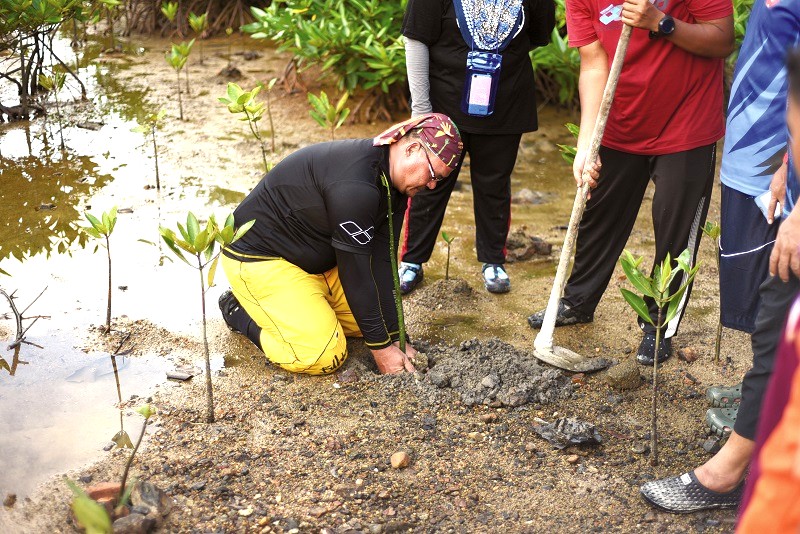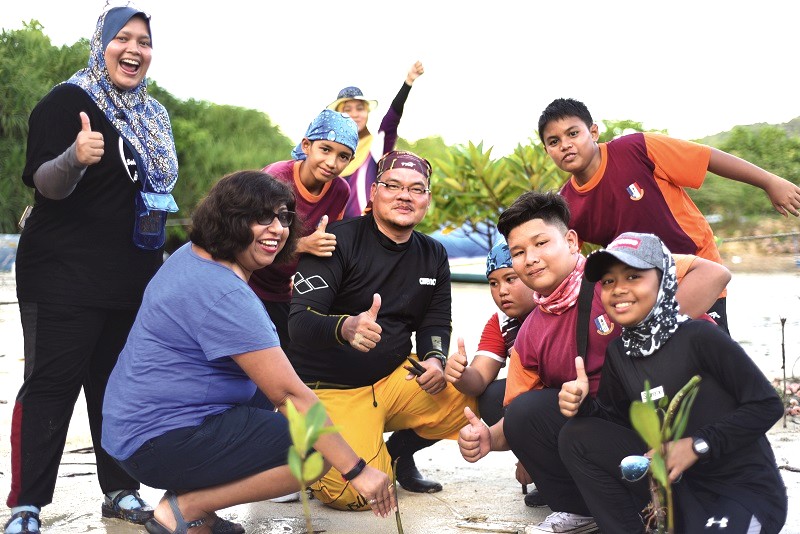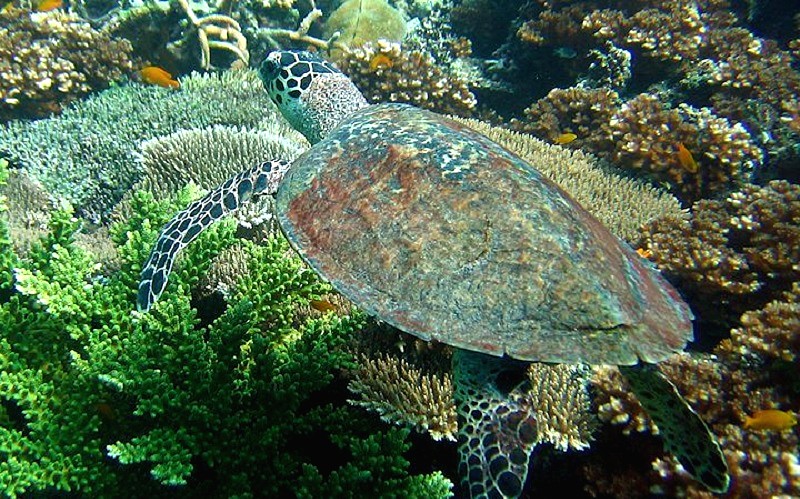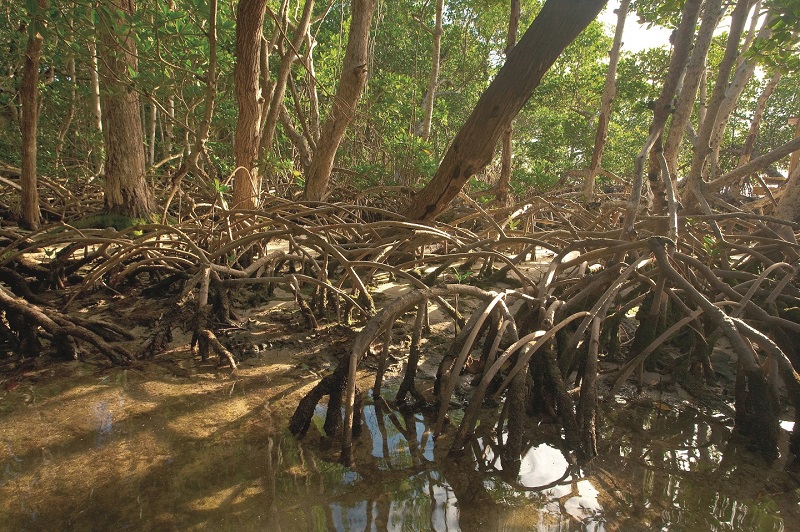
A teacher helping a student replant a mangrove sapling (Photo: Hashimi Ismail)
I reach Redang Island just as the monsoon season starts. There is electricity in the air before the skies darken. A breeze rustles through the palm trees and the air swirls to a fog of water, then bursts through the skies with a welcome breath of cool.
Near the jetty is a sign that should say “1Malaysia” but which someone has truncated to a terse “1Malay”. This is the state that caned two women some months ago, and suddenly, the dark foliage of the island under the thick gathering clouds overhead seems ominous.
The rain starts just as I reach a shack that houses an eatery peopled by two other patrons. It is so small that we start a conversation in the pouring rain. And that is how I meet the remarkable Hashimi Ismail.
dsc_6461.jpg

Hashimi wears a fluorescent yellow shirt and his personality is equally luminous. At 44, he has been teaching science for most of his life and his passion for the preservation of marine ecology is immediately evident. He is in Redang to lead a group of young students in replanting the mangrove forest that has been decimated by rapid tourism.
Specifically, they will be planting mangrove saplings around the new airport runway, which will allow nature to gradually reclaim some of the land. Hashimi, a fisherman’s son from Penang, tells me that the marine life and seas of any island, to him, feel like home. He invites me to visit the next day, an hour before sunset, to see the remarkable work the children are doing.
The next evening, seven teachers are gathered around beached boats and the children — 10 to 12-year-olds — swarm around them. Despite the humid heat, everyone is covered from head to toe, socks on their feet and hats on their heads ... even their necks are protected by scarves. I quickly understand why as evening descends, and the mosquitoes come out.
dsc_6442.jpg

The girls and boys in this group are, like children anywhere, a bubbly enthusiastic group who jostle and tease each other. However, they are budding young ecologists and their enthusiasm for the replanting work is palpable. When Hashimi begins to describe the various plant life surrounding us, a hush descends, until it is time for questions, which they answer with enthusiasm.
This is also a group made shy by a stranger. When I ask a question, young Azhari smiles shyly while Marsya Damia covers her face with her hands and giggles. A bunch of twig-like mangrove seedlings lie on the ground and our first job is to separate the viable ones from the weak. The children already know how to do this whereas I do not, so Mohammad Haikal, wearing a jaunty cap on his head and grinning ear to ear, proffers a bunch of mangrove seeds for me to plant. I ask him to teach me what to do, then perch next to Nur Qhaliesah to manoeuvre a tiny seedling into the swampy ground.
The children are very good teachers. They have travelled far to come here for the weekend — from Sekolah Kebangsaan Menerong and Sekolah Kebangsaan Pereh, two rural primary schools with a mere 131 students enrolled in total. For them, Redang, filled with visitors like me, is a very big town that promises new experiences. The 40 students are accompanied by 12 teachers and will replant the marsh land over a long weekend.
g1c_35.jpg

Hashimi has been working on the management of Pulau Redang Marine Park’s coral reefs since 1998 and sea turtle conservation since 2001; this is a project he hopes will continue for years. He also leads mangrove replanting projects in Kerteh. The Redang mangrove replanting project has been ongoing since 2008 when the Terengganu State Department of Education asked for help in running part of the national level Marine Park Awareness Camp.
The children listen to a lecture on the techniques of replanting and learn about the tenacity of these viviparous seeds on the congenial soil near the jetty area. Then we trek through a narrow path, a slippery incline in places, to reach the nursery site.
Here, the seedlings have sprouted from seeds planted in poly bags over the past few months. The growth is of different heights as the seedlings range from three to five months old. Those that are clearly flourishing will be replanted at suitable sites around the island.
The children name the plants: Bakau minyak (Rhizophora apiculate) and Bakau kurap (Rhizophora mucronata). The teachers point to various other species as we move along: Buta-buta (Excoecaria agallocha), which will blind you for some time; Tumu merah (Bruguiera gymnorhiza); and Teruntum merah (Lumnitzera littorea). These are familiar plants in a familiar tongue and the children say the names easily, telling me that Putat laut (Barringtonia asiatica) is poisonous for the fish. A Mengkuang laut (Pandanus odoratissimus) lies at our feet looking like a grenade but it is actually a harmless sea pineapple.
11799248_xl.jpg

There is some good-natured teasing as someone gets an answer wrong or plants a seedling badly. There is curiosity in the knowledge shared and accumulated, and I can imagine these young students taking this hands-on experience and growing as Malaysian environmentalists, especially in mangrove swamp reclamation, and making this country bloom for generations to come.
My hands are wet and muddy and knees creaky from bending down and straightening up, but it feels like the evening melted into night too soon. The happy faces of the children and staff speak volumes about how satisfying the work was. I am tired and sweaty but the children have an evening programme — to sing and dance on stage.
Their enthusiasm and stamina is contagious. I see in them, and in school programmes like this, hope for Malaysia — one that is respectful of the treasure trove handed down through the generations and complicit in preserving these riches for the generations to come.
Dr Dipika Mukherjee holds a PhD in English (sociolinguistics) from Texas A&M University and is the author of 'Shambala Junction', which won the UK Virginia Prize for Fiction, and 'Ode to Broken Things', which was longlisted for the Man Asia Literary Prize. She lives in Chicago and is affiliated to the Buffett Institute for Global Studies at Northwestern University and is Core Faculty at Story Studio Chicago.
This article first appeared on July 8, 2019 in The Edge Malaysia.


